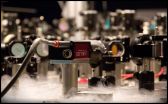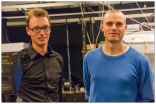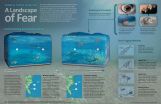INFORMATION:
Contact:
Peter Lodahl, Professor, head of the research group Quantum Photonics at the Niels Bohr Institute at the University of Copenhagen. Tel: +45 2056-5303, lodahl@nbi.ku.dk
Immo Söllner, PhD Postdoc in the research group Quantum Photonics at the Niels Bohr Institute at the University of Copenhagen. sollner@nbi.ku.dk
Sahand Mahmoodian, PhD Postdoc in the research group Quantum Photonics at the Niels Bohr Institute at the University of Copenhagen. sahand@nbi.dk
Søren Stobbe, Associate Professor in the research group Quantum Photonics at the Niels Bohr Institute at the University of Copenhagen. +45 3532-5216, +45 6065-6769, stobbe@nbi.ku.dk
Quantum networks: Back and forth are not equal distances!
2015-07-27
(Press-News.org) Quantum technology based on light (photons) has great potential for radically new information technology based on photonic circuits. Up to now, the photons in quantum photonic circuits have behaved in the same way whether they moved forward or backward in a photonic channel. This has limited the ability to control the photons and thus build complex circuits for photonic quantum computers. Now researchers from the Niels Bohr Institute have discovered a new type of photonic channels, where back and forth are not equal distances! Such a system has been a missing component for building quantum photonic circuits on a large scale. The results are published in the scientific journal, Nature Nanotechnology.
"The smallest component of light is a photon and photons are very well suited for carrying information. A quantum circuit based on photons could contain far more information than is possible with current computer technology and the information could not be intercepted en route. So we are working to shape the future quantum technology based on photonics," explains Peter Lodahl, Professor and head of the research group Quantum Photonics at the Niels Bohr Institute at the University of Copenhagen.
Photonic chips with new properties
Researchers at the Niels Bohr Institute have developed a photonic chip, in which a light source - a so-called quantum dot - is embedded. By shining light on the quantum dot using a laser, its electrons are excited, which then jump from one orbit to another and thus emit a single photon at a time. Light is normally emitted in all directions, but the photonic chip is constructed so that all of the photons are sent out through a photonic channel. So far so good. But the problem is that the photons are sent in both directions in the photonic channel and this limits the efficiency of the light source. This is a problem that grows, the bigger and more complex the circuit becomes.
"In our work to resolve the problem, we have now developed a new photonic channel where we can control the photons so that they are only sent in one direction. It is a fundamental new discovery, that you can get the emission of light in a photonic chip to take place in a manner not previously thought possible," explains Peter Lodahl.
Controls the direction of the photon emission
Immo Söllner and Sahand Mahmoodian, both postdocs in the research group Quantum Photonics, have worked with both the theory and the experiments. They explain that they use laser light to excite the quantum dot's electrons, which jump from one orbit to another and thereby emit a single photon. By controlling the spin of the electrons with a magnetic field, you can get an entirely different light emission. A photon emitted from a quantum dot with an electron "spin down" chooses one direction, while the photon from a quantum dot with an electron "spin up", chooses the opposite direction.
Delay in one direction
The most exciting thing about the new photon channels is perhaps not even that the direction of the light emission depends on the spin of the quantum dots. It also turns out that a photon that enters from one end of the channel behaves differently than a photon that enters from the other end. Only when the photon moves in one direction does it interact with the quantum dot and this slows the photon a little bit, just as if the photon had travelled a little farther. In this system, back and forth are therefore not equal distances! And unequal distances are not unimportant, but on the contrary, extremely important.
"The photon is delayed a bit because it interacts with the quantum dot. We now have a number of new opportunities to control and design the interaction between a photon and a quantum dot, which is important for the development of quantum computers," explain Immo Söllner and Sahand Mahmoodian.
Paves the way for new quantum technology
Søren Stobbe, who is an associate professor in the Quantum Photonics group at the Niels Bohr Institute, has led the production of the new light sources that has been developed in collaboration with Professor Jin Dong Song's research group at the Korea Institute of Technology, and he adds that the new technology has the great advantage that it is based on the same semiconductor materials known from the computer industry. This means that the path from the laboratory to application is the shortest possible, although the researchers themselves estimate that it will require significant investment.
"We can control the state of the quantum dot and thereby determine the direction in which the photon is emitted and whether the light, which moves in one direction or the other, needs to be delayed. This is a completely new functionality that will have some practical advantages when we start constructing quantum networks, which are expected to have great potential for calculating difficult problems in chemistry and materials technology. Therefore, we have patented our discovery and are working towards commercialisation," says Professor Peter Lodahl.
ELSE PRESS RELEASES FROM THIS DATE:
Yale study identifies 'major player' in skin cancer genes
2015-07-27
New Haven, Conn. -- A multidisciplinary team at Yale, led by Yale Cancer Center members, has defined a subgroup of genetic mutations that are present in a significant number of melanoma skin cancer cases. Their findings shed light on an important mutation in this deadly disease, and may lead to more targeted anti-cancer therapies.
The study was published July 27 in Nature Genetics.
The role of mutations in numerous genes and genomic changes in the development of melanoma -- a skin cancer with over 70,000 new cases reported in the United States each year -- is well established ...
New treatment options for a fatal leukemia
2015-07-27
Acute lymphoblastic leukemia (ALL) frequently develops between the age of two and three. This leukemia has various forms, which differ through certain changes in the genetic material of the leukemia cells. A team of scientists involved in a joint international project headed by Jean-Pierre Bourquin, a pediatric oncologist from the University Children's Hospital Zurich, and Martin Stanulla, a professor at Hannover Medical School, has now succeeded in decoding the genome and transcriptome of an as yet incurable sub-type of acute lymphoblastic leukemia. These results were ...
Smaller, faster, cheaper
2015-07-27
In February 1880 in his laboratory in Washington the American inventor Alexander Graham Bell developed a device which he himself called his greatest achievement, greater even than the telephone: the "photophone". Bell's idea to transmit spoken words over large distances using light was the forerunner of a technology without which the modern internet would be unthinkable. Today, huge amounts of data are sent incredibly fast through fibre-optic cables as light pulses. For that purpose they first have to be converted from electrical signals, which are used by computers and ...
Weight loss for a healthy liver
2015-07-27
Bethesda, MD (July 27, 2015) -- Weight loss through both lifestyle modification and bariatric surgery can significantly reduce features of nonalcoholic steatohepatitis (NASH), a disease characterized by fat in the liver, according to two new studies published in Gastroenterology, the official journal of the American Gastroenterological Association.
"While the underlying cause of NASH is unclear, we most commonly see this condition in patients who are middle-aged and overweight or obese," said Giulio Marchesini, MD, from University of Bologna, Italy, and lead author of ...
Sochi Winter Olympics 'cost billions more than estimated'
2015-07-27
As the International Olympic Committee prepares to choose between Beijing (China) and Almaty (Kazakhstan) as the host of the 2022 Winter Olympics, a new report shows that the cost of last year's Games in Sochi, Russia, has been underestimated by billions of dollars.
Ahead of the decision on 31 July, a study by Dr Martin Müller of the University of Birmingham finds that:
The Sochi Games cost $16bn in sports-related expenditure alone - more than twice the official figure of $7bn
Total costs, including capital costs, amount to $55bn
Sochi is the most expensive ...
At what age does hard work add a shine to lousy prizes?
2015-07-27
Putting in a lot of effort to earn a reward can make unappealing prizes more attractive to kindergartners, but not to preschoolers, according to new research published in Psychological Science, a journal of the Association for Psychological Science. The findings revealed that when 6-year-olds worked hard to earn stickers that they ultimately didn't like, they were loath to give them up, whereas 4-year-olds were comparatively eager to give the unappealing stickers away.
"When effort leads to an unsatisfying reward, adults experience a cognitive dissonance, arguably resolved ...
Mum's the word: Maternal language has strong effect on children's social skills
2015-07-27
Psychologists at the University of York have revealed new evidence showing how specific language used by parents to talk to their babies can help their child to understand the thoughts of others when they get older.
Studying the effects of maternal mind-mindedness (the ability to 'tune in' to their young child's thoughts and feelings), lead author Dr Elizabeth Kirk observed 40 mothers and their babies when they were 10, 12, 16, and 20 months old.
Keeping a record of parental language while a mother and her child played for 10 minutes, psychologists logged every time ...
Scientists study predator-prey behavior between sharks and turtles
2015-07-27
MIAMI - A new collaborative study led by scientists at the University of Miami (UM) Rosenstiel School of Marine and Atmospheric Science & Abess Center for Ecosystem Science & Policy examined predator-prey interactions between tiger sharks and sea turtles off the northwestern Atlantic Ocean.
The research team used long-term satellite tagging data from large tiger sharks and adult female loggerhead sea turtles, common prey of tiger sharks, to examine their movement patterns and evaluate if turtles modify their behaviors to reduce their chances of a shark attack when turtle ...
Device innovation is driving improvement in stroke treatment outcomes
2015-07-27
SAN FRANCISCO, CA - July 27, 2015 - In the last decade, Intra-Arterial (IA) stroke therapy (a technique in which thrombolytic agents and devices are passed through the arteries directly to the clot site) has gained notable momentum as an effective and safe treatment option for patients. Two new studies released today at the Society of NeuroInterventional Surgery 12th Annual Meeting in San Francisco, further reinforce the value and progress of IA treatment with conclusions that the innovative new devices that facilitate this approach are reducing treatment times, improving ...
Emergency transport times for stroke patients still in need of improvement
2015-07-27
SAN FRANCISCO, CA - July 27, 2015 - Despite efforts to close the time gap between symptom onset and stroke treatment - including improvements in public education, 911 dispatch operations, pre-hospital detection and triage, hospital stroke system development, and stroke unit management - a new study presented today at the Society of NeuroInterventional Surgery (SNIS) 12th Annual Meeting suggests that delays in emergency transport are still prevalent and that improvements are needed to ensure patients can be treated within the optimal time window.
Perhaps more than any ...



